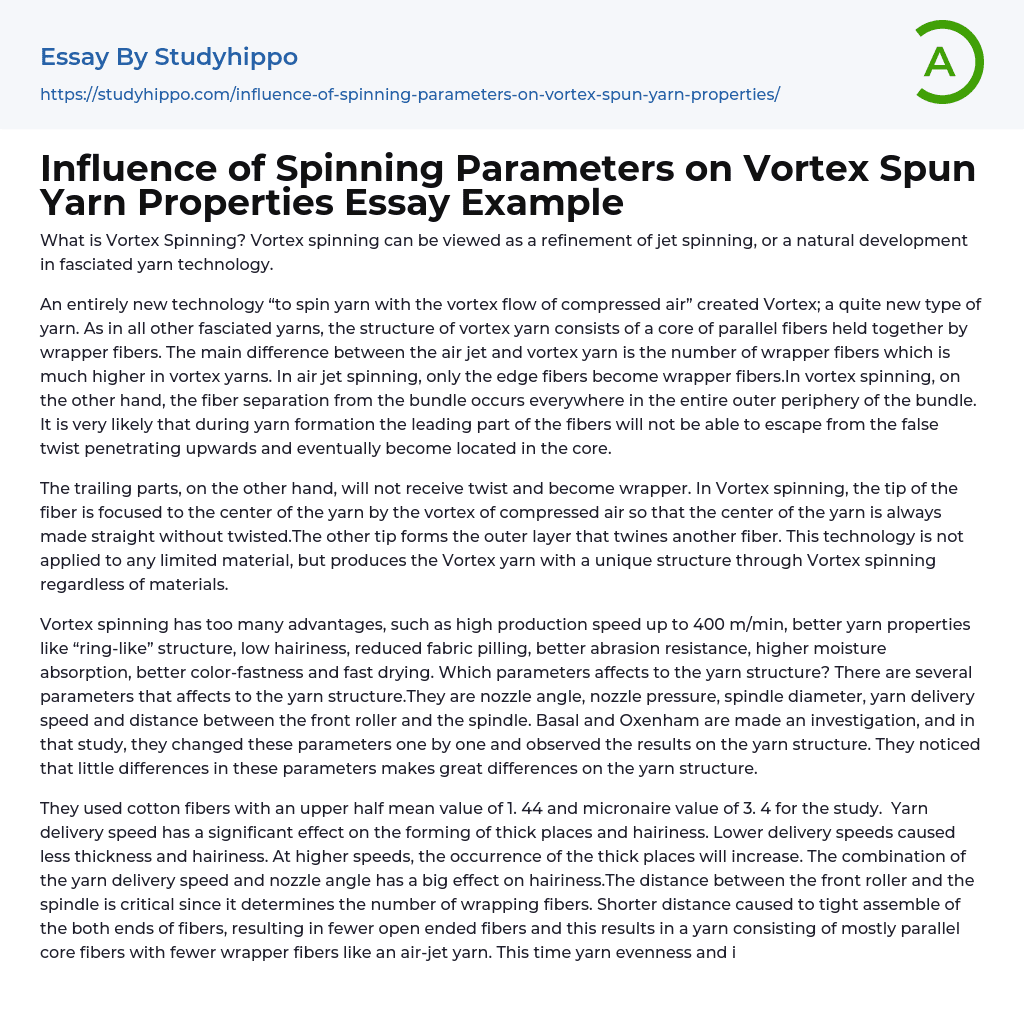

Influence of Spinning Parameters on Vortex Spun Yarn Properties Essay Example
What is Vortex Spinning? It can be seen as an improvement of jet spinning or a natural progression in fasciated yarn technology. Vortex is a completely new technology that uses compressed air's vortex flow to spin yarn, resulting in a distinct type of yarn.
In vortex yarn, similar to other fasciated yarns, the structure consists of a core made up of parallel fibers held together by wrapper fibers. The main distinction in vortex yarns is the higher number of wrapper fibers compared to air jet spinning. In air jet spinning, only the edge fibers act as wrappers. However, in vortex spinning, the separation of fibers from the bundle occurs all around the outer periphery of the bundle. During yarn formation, it is likely that the leading portion of fibers will be unable to escape the upward-penetrating false twist and ultimately become located in the core. Conversely, the trailing parts
...do not receive twist and become wrappers. In vortex spinning, the compressed air vortex focuses the tip of the fiber towards the center of the yarn, ensuring that the center remains straight without any twisting. The other fiber tip forms the outer layer that intertwines with another fiber.
Regardless of the material used, Vortex spinning technology creates Vortex yarn with a unique structure. This technology offers numerous advantages, including high production speed (up to 400 m/min), improved yarn properties (such as a "ring-like" structure, reduced hairiness, decreased fabric pilling, enhanced abrasion resistance, higher moisture absorption, better color-fastness, and faster drying). The yarn structure is influenced by various parameters. These parameters include nozzle angle, nozzle pressure, spindle diameter, yarn delivery speed, and the distance between the front roller and
the spindle. Basal and Oxenham conducted a study in which they individually altered these parameters and observed the resulting effects on the yarn structure.
They observed that slight variations in these parameters have a substantial impact on the yarn structure. For the study, they utilized cotton fibers with an average upper half value of 1.44 and a micronaire value of 3.4. The speed at which yarn is delivered greatly influences the formation of thick areas and hairiness.
Lower delivery speeds lead to decreased thickness and hairiness. However, when the speeds are higher, there is an increase in the occurrence of thick spots. The yarn delivery speed and nozzle angle together greatly influence the level of hairiness. Additionally, the distance between the front roller and the spindle plays a crucial role as it determines the quantity of wrapping fibers. A shorter distance causes the tight assembly of both ends of fibers, leading to a reduced number of open-ended fibers. As a result, the resulting yarn mainly consists of parallel core fibers with fewer wrapper fibers similar to an air-jet yarn.
This time, the yarn evenness and imperfections are improved because there is a lower risk of losing control over the fibers during the bundling of the parallel core fibers, which make up the majority of the yarn alongside a few wrapper fibers. Additionally, the waste is reduced thanks to better fiber control, and the yarn has a lower level of hairiness. In contrast, under different conditions, there is an increase in wrapper fibers and reduced fiber control. Consequently, the resulting yarn becomes softer due to the increased presence of wrapper fibers and exhibits more hairiness with longer strands. However,
the waste fiber rate is higher when compared to the short setting.
Increasing the nozzle pressure leads to an increase in both axial and tangential velocity, resulting in an increased flow of fiber bundles.
- Jeans essays
- Clothing essays
- Cosmetic Surgery essays
- Fashion design essays
- Footwear essays
- Automobile essays
- Bus essays
- Civil engineering essays
- Cycling essays
- Electric Car essays
- Genetic Engineering essays
- Hybrid essays
- Innovation essays
- Internal Combustion Engine essays
- Invention essays
- Mechanical Engineering essays
- Mechanics essays
- Software Engineering essays
- Telephone essays
- Atom essays
- Big Bang Theory essays
- Density essays
- Electricity essays
- Energy essays
- Force essays
- Heat essays
- Light essays
- Motion essays
- Nuclear Power essays
- Physiology essays
- Sound essays
- Speed essays
- Temperature essays
- Thermodynamics essays



